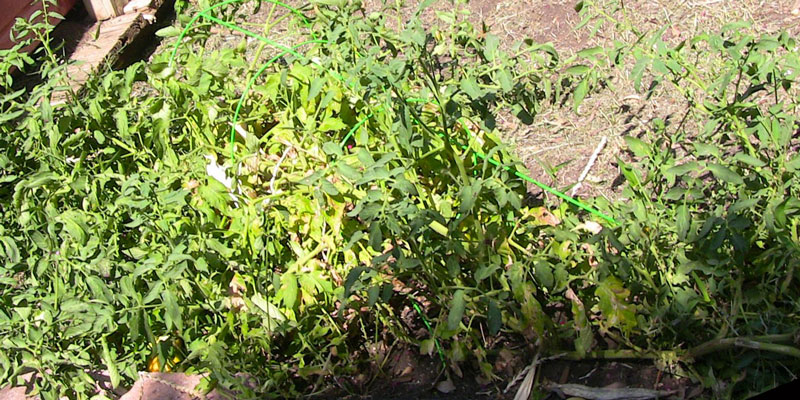Q&A – Ask Neil: July 20, 2023
(Please read these instructions carefully.)
Before you post your question, please look at recent issues to see if someone else has already asked it. You might find your answer there.
How to submit your question…
(Note: You may need to allow a pop-up window to come up in order to get the link for sending your photo(s). If you have already submitted your question and didn’t see the pop-up window, please click here.)
• Click the link provided below to post your question. After you submit your question, a new window will pop up giving you the address to which you can e-mail a SHARP, HIGH-RESOLUTION PHOTO to accompany your question. Please DO NOT SEND THUMBNAIL PHOTOS in case I need to zoom in to see things.
• Click here to post your question.
• Please ONLY POST YOUR QUESTION ONE TIME. We can only accept a set number of questions each week, and when we get duplicates it costs other people their chances.
• One question per reader, please.
• Please use this only for posting questions – not for standard emails.
• Watch for your answer in the following week’s e-gardens.
• I choose those of greatest general interest. For example, plant IDs seldom make the cut.
• I must have your first name or initials.
• I must have your city or county. (Texas is a very large state.)
QUESTION 1
WHAT IS THE DIFFERENCE IN MY PRIDE OF BARBADOS?
Question: I bought Pride of Barbados (Caesalpinia pulcherrima) and planted them into the ground in May 2020. They freeze to the ground and always come back. I purchased three more and planted them in June 2022. They grew great and bloomed about the same, but they had big thorns, and they did not come back. What is the difference? Sandra S., Temple.
Answer: Pride of Barbados plants do have thorns. It’s a fabulous subtropical shrub or woody perennial that will freeze to the ground and come back strongly in the spring in the middle belt of Texas. However, the extreme cold we had last year came very early in the winter (December) and our plants were not yet well acclimated. Species and varieties that survived the even colder weather of February 2021 were in a different condition and ended up being killed by the cold of December 2022. I’m pretty sure that’s what the difference would have been.
QUESTION 2
DOES THIS SCALE WARRANT TREATMENT ON MY WINTERCREEPER?
Question: I planted purple wintercreeper euonymus by the side of my house in fall 2021. It is doing very well there, but I have noticed a small portion has this outbreak of scale. Should I treat for it? Daniel D., Keller.
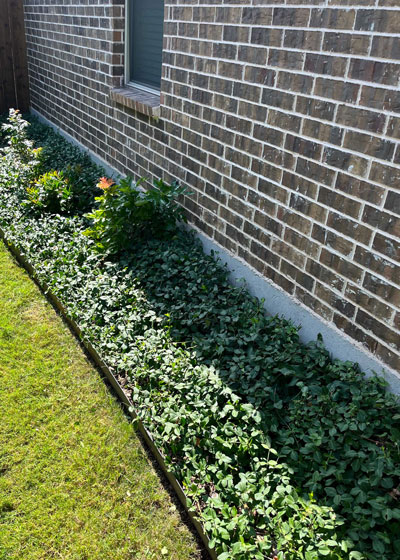
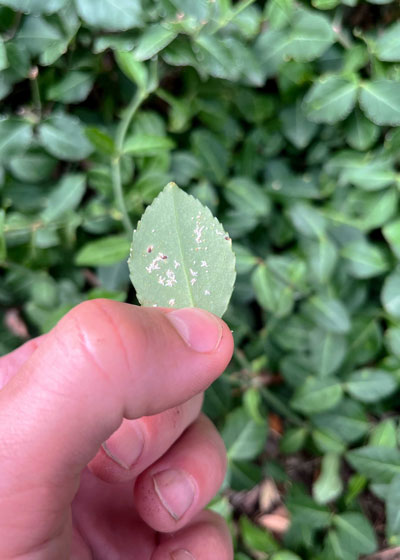
Answer: Yes. Euonymus scale is a tough cookie. When it appears on shrubby types of euonymus it spells almost sure death for them. It is, thank goodness, not nearly as troublesome on wintercreeper used as a groundcover. I have several large beds of wintercreeper, and I notice scale only when it either climbs up a tree trunk or grows into fairly heavy shade. I would suggest using a sprinkling can to apply Imidacloprid systemic insecticide as a soil drench, then spraying with the same material at the recommended spraying strength. The scale won’t fall off even after it dies, but hopefully you’ll notice that it isn’t spreading. Stay on top of it. I don’t think it will be a big problem for you.
QUESTION 3
WHY IS MY SKY PENCIL HOLLY DYING? IT’S IN A DARK CORNER WITH ONLY A FEW HOURS OF SUN EACH DAY.
Question: My Sky Pencil holly was initially thriving with lots of new, green leaves. Now it’s slowly turning brown and dying. I previously had a Japanese yew in this location, but it slowly died over a period of a couple of years. The spot only gets a few hours of sun each day. What is the problem? John M., Frisco.
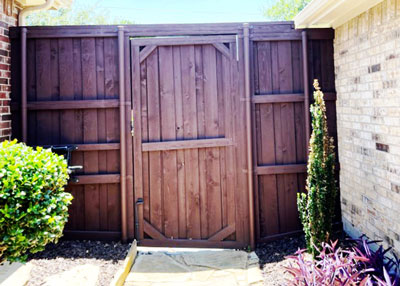
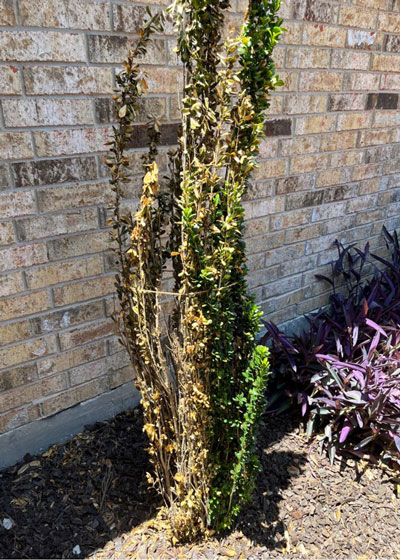
Answer: For the Sky Pencil holly the problems are your soil and your irrigation water. Frisco has highly alkaline soil and Sky Pencil is a Japanese holly hybrid (Ilex crenata). That entire clan must have acidic soils. Sky Pencil is suited to East Texas and the South, but not to the Blackland Prairie and the very alkaline soils. It and the rest of the Japanese holly hybrids should not be sold for the Metroplex area. As for Japanese yew, they have a narrow range of tolerance for sun/shade, drainage and cold. The past two winters killed almost all of them in North Texas. In fact, February 2021 killed them almost all the way to the Gulf Coast. You would be better served by Scarlet’s Peak yaupon if you want an extremely vertical holly. I use Oakland holly. It’s slightly wider, but it is a really dependable grower. I just bought one the other day.
QUESTION 4
IS CLEVELAND PEAR A GOOD ALTERNATIVE TO BRADFORD PEAR?
Question: I’m looking for an alternative to Bradford pears. I’ve heard of Cleveland pear but I’m unable to find it in local nurseries. Is there another tree similar to either of these trees that can be sourced locally? Alex M., Coppell, Dallas County.
Answer: Cleveland pear is just another selection of ornamental pear that has the same issues as Bradford pear. It’s invasive because of fruit that forms both on it and on its rootstock. Its trunks split due to narrow branch angles just as Bradfords do. And it’s subject to both fire blight and especially cotton root rot. These trees are being strongly discouraged by nursery experts and landscape architects, also by conservationists who are very concerned about how the seedlings are overtaking wetlands across the South, East Coast and Midwest. Some states are even prohibiting future sales of them.
As for the best alternative with somewhat upright/pyramidal growth form, by far the best would be dwarf southern magnolias. Little Gem grows to be 35 ft. tall and 25 ft. wide. Granted it’s slower growing, but it also lives 10 or 20 times longer than the pears. If you want something much smaller, Teddy Bear dwarf southern magnolia would fit the bill.
QUESTION 5
WHY WOULD MY REDBUD TURN YELLOW AND LOSE ITS LEAVES SO SUDDENLY?
Question: Why would my redbud turn yellow, then brown so suddenly? Is there a remedy? I live near the old Channel 5 Broadcast Hill facility. Denise C., Fort Worth.
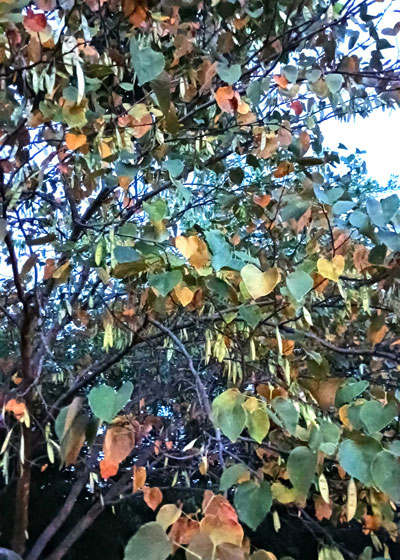
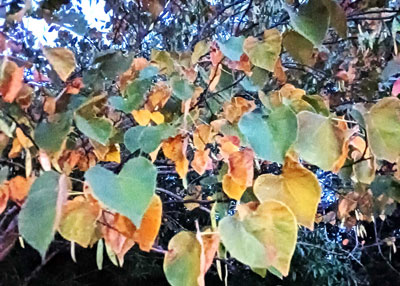
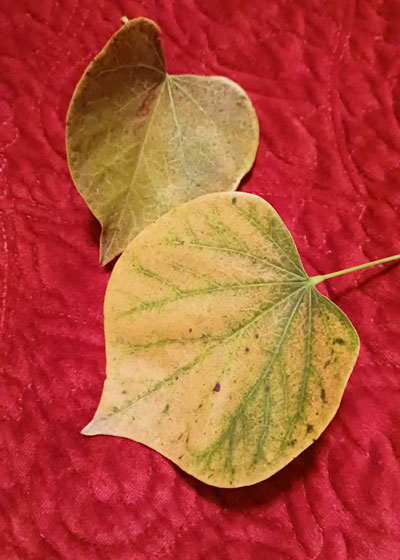
Answer: I drove to that facility probably 100 times in the 1970s to work with Chip Moody, Bobby Wygant and Harold Taft. Those were great people and wonderful days. I probably drove past your tree – assuming it was there that far back.
Redbuds have life expectancies of 30 to 40 years. It’s not uncommon for them to decline rather rapidly, often because of an insect known as the redheaded wood borer. It looks somewhat like a small yellowjacket with a burgundy-red head. Their exit holes in the limbs and trunk are about the size of a pencil lead. You might check to see if they are present. I don’t see any evidence of a leaf disease on the two leaves in your photo. Assuming it’s not just age-related, whatever problem the plant has would be in the trunk or roots, and I can’t see it in the photos. As for a remedy, it’s been my experience with many redbuds in our 11-acre wooded forest, that once they get to this stage, there isn’t anything we can do to reverse this sort of a problem with redbuds.
QUESTION 6
WILL WATER OAK OR WILLOW OAK, ALSO SAVANNAH OR FOSTER HOLLY DO WELL FOR ME?
Question: Will I succeed with water oak or willow oak, also Savannah or Foster hollies? I have loblolly pines, a slash pine and a bald cypress tree. They have been in the ground for 5 to 7 years and all appear to be doing fine. I have slightly acidic, heavy clay soil. Heath T., Whitesboro.
Answer: If you have had the soil tested by a reputable soil-testing laboratory and have a confirmed pH below 7.0, and especially if your irrigation water is also slightly acidic, all of those plants should have a good chance of surviving for you. However, don’t overlook Chinquapin oaks, bur oaks and the many hybrids of Chinese hollies such as the common Nellie R. Stevens and Willowleaf hollies, also the dozen or so “Red” hollies and Warren’s Red possumhaw holly. All of those are failsafe in any type of soil.
QUESTION 7
HOW DO YOU MAKE TOMATO CAGES FROM CONCRETE REINFORCING WIRE?
Question: Tomato cages we buy at the nursery are never tall enough. Our plants fall over from their own weight. Please describe how you make them from concrete reinforcing wire. Steve R., Arlington.
Answer: It would help if you could split the bill with several other gardeners because a roll of the wire is rather pricey. Cut 50-in.-long pieces of the wire, then twist each one together to form a cylinder approximately 16 in. in diameter and the height of the wire. Rip a pressure-treated 2×4 6 ft. long to make two stakes, one for each side of the cage. Position them on the north and south sides, the two directions from which the strongest winds are likely to come. Drive them at least 12 in. into the ground to anchor them firmly. Keep all suckers pushed back within the cages and you should have very good results.
QUESTION 8
WHAT HAS HAPPENED TO MY COLOR GUARD YUCCAS?
Question: I have six Color Guard yuccas, and this has happened multiple times to multiple plants. They are doing great one day and wilted to the ground the next. They can be pulled out with no effort. What’s going on? Paul S., San Antonio.

Answer: If you were farther north I would guess this was leftover freeze damage, but not in San Antonio and not showing up halfway through the summer. Color Guards will not tolerate wet soils. I lost mine by June their first year in my garden. I know the soil stayed too wet due to drainage down a hillside. I have observed many others that haven’t been able to withstand plantings in with other regular plants. They must be in xeriphytic settings (raised beds of very well-draining soils). I have never seen an insect or disease involved with these deaths.
QUESTION 9
IS THIS IRON DEFICIENCY IN MY LANTANAS?
Question: The nursery told me they thought this was iron deficiency in my lantanas. I have never seen that before. Do you think that is an accurate analysis? Linda, North Richland Hills, Tarrant County.
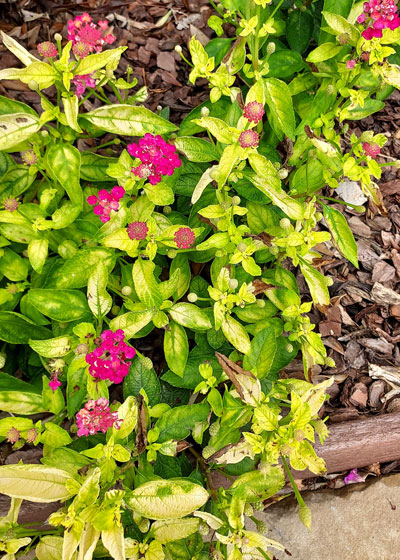
Answer: Yes, but I’ve never seen it, either. For others who may not be familiar with iron deficiency, it will show up as yellowed leaves whose veins remain green the longest. It will be most prominent on the newest growth. As it becomes extreme the leaves will turn white, then brown and crisp. You are seeing all of that happening.
Other things can cause iron shortages to occur when there is actually ample iron in the soil. It can be wash across the surface of the soil from a granular weedkiller applied to the lawn nearby. A gas leak will discolor foliage like this. Poor drainage can damage roots badly enough that they don’t take nutrients up normally. So can grub worms.
I do not think this is damage of lace bugs. Just to be sure, however, look at the backs of the leaves for the tiny black specks of lace bug excrement. They love lantanas, but they usually cause a lot more mottling than I see in the photo above.
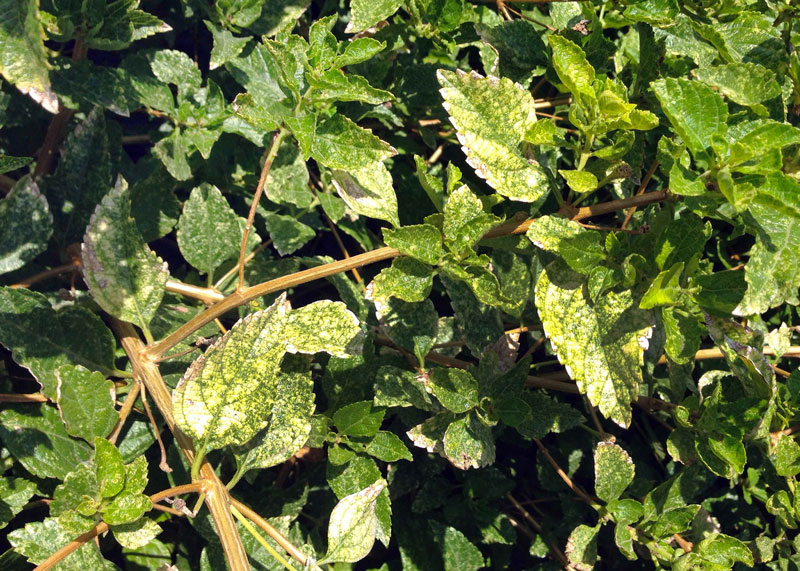
I would suggest applying a water-soluble plant food with iron and sulfur added to see if it gives a quick green-up.
Note: Linda called my radio program this past weekend. I asked that she send me a photo to help me confirm my identification of her problem. I just couldn’t picture lantanas with iron deficiency as severe as she was describing.

